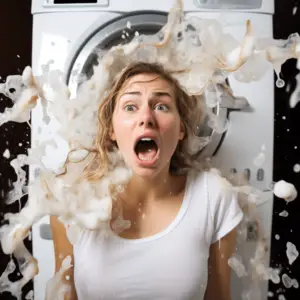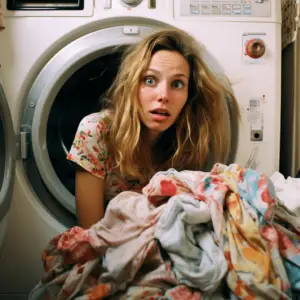Smelly Washing Machines, Have you noticed that your washing machine smells worse than it did before you cleaned it? The washing machine may reek, but there is no need to panic. There are a few reasons for this and there are things you can do to deal with a smelly washing machine. This article takes a look at these reasons and things you can do to resolve this.
Table of Contents
Washing machine smells worse after cleaning: The Main Problems

First of all, a washing machine smelling after cleaning could be a sign that cleaning it actually worked. Chances are the cleaning agent you utilized or even the hot water broke up some hidden gunk that didn’t get washed away as expected and now it’s sitting in your machine. Here are some of the common reasons why your washing machine smells even after cleaning.
Something stuck in the Door Seal
It’s good to note there is a large rubber door seal that goes around the door of a front-loader washing machine, which is meant to keep water from getting out of the machine during a cycle.
However, if a small piece of clothing, like a sock, gets stuck inside the gasket, it can get covered in mildew over time. When this happens and is left for too long, it will start to smell bad. Here’s is what to do to make sure the door seal doesn’t have anything stuck in it:
Start by pulling door seal back, and check inside for any loose clothing items. And if you see any, be sure to remove it. Next, give the door gasket a thorough cleaning with hot soapy water. After that leave the door open so that it can dry completely in and out.
It usually best to leave the door open in your front-loader washing machine after every cycle to get it dried. This will also help to stop mold from developing and accumulating.
Clogged Drain Plug/Pump
Another possible cause of the issue is a clogged drain plug in a front-loader washer. In most models, you’ll find a drain plug at the bottom of the washer on either the front, sides or back of the appliance. Here’s what you need to do to check the drain plug and the filter:
First, you need to locate the drain plug. Check whether it has a cover plate and remove it if it has one. Once you’ve accessed the drain plug, turn the cap off. You might want to have some old towel in handy as some old water might leak from it.
After removing the plug, proceed into the hole and take the drain filter out. Give both the drain plug and the filter a good clean with hot, soapy water in the sink. Use hot soapy water to clean the areas around the filter and filter as well.
After that put a glass of hot water mixed with two drops of white vinegar into the washing machine drum. The water should drain out through the hose, taking out any grime that is stuck in there.
After cleaning all the parts, put them back in the washer. If that doesn’t work and you can still smell an awful smell, then you will need to run your washing machine on a cleaning cycle and inspect the sewer.
Dirty Washing Machine
If you own a top-loader washing machine, then perhaps the best way to get rid of the awful smell is to give it a good clean; failure to which mold, grime, and mildew will start developing in your washing machine- which will bring about a bad smell. So, here’s how you can clean a smelly washing machine:
The first thing is to open the washer’s door. Set the washer to the hottest setting and the maximum load capacity. As the water starts filling up, add one quart of the beach (around four cups) to the water inside the washer. Close the lid and turn it on to a long spin cycle, once the washer is full of water.
Once the cycle has ended leave the washer for about one hour before it back on and subject it to a standard wash cycle. When the cycle is over, turn it again to the hottest setting and maximum load capacity and when it’s filling up, add three cups of white vinegar and a half cup of baking soda.
When full, close the lid and turn it to a long spin cycle again. After the end of the spin cycle, open the lid and wipe the washing machine out with a clean cloth. Leave the washer lid open, allowing to dry for a couple of hours before using it again. If the washer still smells, then the sewer is the problem.
The Sewer is Clogged
In case cleaning your washing machine didn’t work, the final reason could be that the drain or sewer is clogged. When this happens, a bad smell can get through the drain hose and into the washing machine itself. Here’s how to resolve this problem:
Start by locating where the drain is connected. Smelly Washing Machines is usually connected to a standpipe that is then connected to your sink. Take the hose from the standpipe and inspect to see whether there’s a smell coming from the standpipe. If it’s smelly, give the entire area around the standpipe a good clean with hot soapy water.
The p-trap could also be faulty, allowing sewer gas to come up through the drain hose and into the washer. To fix this issue, simply pour a bucket of hot, soapy water down the standpipe. If that works and the smell disappears, then it means the p-trap was the problem. Pouring hot water down the drain could get the p-trap working again, but sometimes, it might need a replacement. So, Smelly Washing Machines the smell keeps on coming, consider getting a plumber to help replace the p-trap.
Washing machine smells worse after cleaning: Prevention

Smelly Washing Machines dealing with a smelly washer, there are a few things you can do to prevent the odor from coming back. Always keep your washing machine door open between washes. This will let excess moisture evaporate and prevent mildew growth. Consider using high-efficiency (HE) detergents. In case your machine is a high-efficiency appliance, high-efficiency detergents will help minimize soap scum build-up. Remember to clean your gasket regularly as it is the most likely suspect for washing machine smells.


